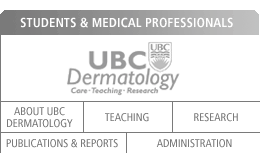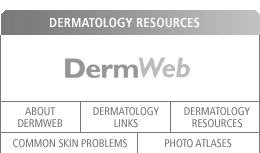|
|
 |
 |
 |
Skin Cancer
The three most common forms of skin cancer are: Basal Cell Carcinoma, Squamous Cell Carcinoma and Melanoma. Actinic Keratosis is a skin condition that results from sun damage, and is considered a pre-cancerous growth.
Basal Cell Carcinoma is the most common type of skin cancer. It grows very slowly and doesn’t spread to other parts of the body. It looks like a sore or spot which won’t heal, that bleeds, can crust, and is usually on the face, ear, scalp, and neck, but can sometimes be found on the back, shoulders, arms or legs.
A skin condition call Actinic Keratosis is considered to be a type of pre-cancer, and looks like small pink and reddish spot sometimes accompanied by a thickening of the skin. It is seen on the sun-exposed areas of the face, as well as the backs of hands, forearms, and legs. It can also be seen also on the scalp of bald men, as well as on their ears and lips. Although actinic keratoses may first develop in the 30’s, it becomes more common as people age and 80% of people over 70 who have fair skin will have actinic keratoses. Actinic keratosis can develop into Squamous Cell Carcinoma.
Squamous Cell Carcinoma develops on the skin as areas that are slightly elevated and reddened, with a scaly area as part of the lesion. The area can change colour, arise from old scars, develop a wart-like surface or even a crust. Squamous Cell lesions usually appear on the face, neck, ears, backs of hands, forearms, and legs. The lesions can begin to bleed, or the skin may look broken and may become painful.
The most dangerous form of skin cancer is Melanoma. The early warning signs that a mole or lesion may be Melanoma fall under the ABCD diagnosis:
- A - Asymmetry
(if moles are not round and symmetrical)
- B - Border
(uneven borders may indicate skin cancer)
- C - Color
(varied shades of brown, tan or black and also red, white, and blue may indicate skin cancer)
- D - Diameter
(if a spot is larger than a pencil eraser (6mm or ¼" diameter) then a dermatologist needs to examine it to rule out skin cancer)
Although the above guidelines are a general warning sign list, skin cancer can take many forms. Anything that changes, grows or fits any of the ABCD’s above should be taken seriously, and a dermatologist should examine anything suspicious. Heredity can play a major role in melanoma risk, as approximately one of every ten patients diagnosed with melanoma has a family member with a history of the disease.
Being successful in dealing with skin cancer involves two main strategies: Prevention, and Early Detection.
Prevention
As many skin cancers are caused by excessive sun exposure, the easiest way to prevent the majority of skin cancers is to protect your skin from the sun. This involves the following:
- Using a high SPF (30+) sunscreen with the Canadian Dermatology Association logo when going out into the sun, and applying it properly. Make sure to apply lotion 15 minutes before sun exposure, and re-apply as necessary (usually every 2 hours).
- Keeping out of the sun during the hottest times of the day – 11 am to 3 pm. Not only is the sun hottest during this time, but the ultraviolet rays are also the strongest. If you can limit your exposure during this time you will reduce the sun’s impact dramatically.
- Use protective clothing, such as large hats and UV protecting garments, and sunglasses that are UV coated.
Early Detection
Many skin cancers are initially discovered by the patient themselves or their family members.
Sores that don’t heal within 3-4 weeks are also suspect. Most skin cancer that is diagnosed early, treated promptly and appropriately can be cured.
If you notice any change on your skin, any unexpected growth, or any unusual discoloration, consult your doctor. Every diagnosis of skin cancer begins with a thorough examination of the skin growth or lesion under good lighting. A biopsy may be taken, as this is the most accurate diagnostic test.
The Skin Care Centre has several dermatologists who specialize in various forms of skin cancer and are active in its research.
« Back to Common Skin Disorders
modified 012408 |
|
 |
|

